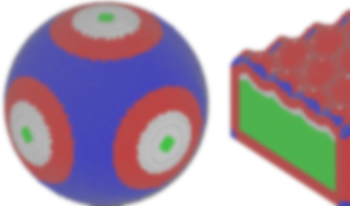2.
In this section, a description of IMCDP, the 2D iterative halftoning method is given. This method is described in detail in Ref. [
2]. The IMCDP method starts with a blank image with the same size as the original image. The first dot is placed at the position where the original image holds the maximum pixel value. Then, a very small number is set at this position in the original image to make sure that this position will not be found as the maximum again. The effect of this dot placement is then fed-back into the halftoning process by subtracting a neighbourhood of the position of the found maximum by a filter, which is referred to as the feed-back filter, hereafter. By doing so, the probability to find the next maximum in that neighbourhood is reduced. This process proceeds and in each iteration one dot is placed at the position of the maximum pixel value and the effect of the placed dot is fed-back by an appropriate filter until a pre-determined number of dots are placed. The feed-back filter plays an important role on the halftone structure of the final reproduced image. Different appropriate filters can generate different halftone structures, shapes and alignments [
3]. In order to generate symmetrical and well-formed first-order FM halftones having blue-noise characteristic, the following Gaussian function is used in the feed-back process,
where
K is a normalization factor to make the filter elements sum to one. In Ref. [
4], it was discussed that
σ = 1.7 generates halftones that result in the smallest average mean squared error when tested on many different test images. It is also possible to generate non-symmetrical first-order FM halftones with different alignments by using a non-symmetrical feed-back filter. Equation (
2) shows such a non-symmetrical (elliptical) filter:
The constants
A,
B, and
C are calculated by [
20]
The parameters
K1 and
K2 are used to adjust the symmetry of the filter. Note that, by setting
K1 =
K2 = 1 and
ϕ = 0, the filter in Eq. (
2) becomes identical to that in Eq. (
1), representing a symmetrical Gaussian filter. On the other hand,
K1 >
K2 makes the halftone dots grow faster in the vertical direction creating vertical line halftones, while
K1 <
K2 performs the opposite. The parameter
ϕ specifies the orientation of the line halftones, i.e. the angle between the line halftones and the positive
y-axis if
K1 >
K2 or the angle between the line halftones and the positive
x-axis if
K1 <
K2. Figure
1 shows the halftone images generated by three different feed-back filters. As can be seen in Fig.
1(a), the symmetrical Gaussian function in Eq. (
1) was used, creating symmetrical first-order FM halftones. In Fig.
1(b), the function in Eq. (
2) with
k1 = 1,
k2 = 3 and
ϕ = 0 was used to create horizontal line halftones. In Fig.
1(c), the function in Eq. (
2) with
k1 = 3,
k2 = 1 and
was used, which resulted in line halftones rotated
with respect to the positive
y-axis. It is also possible to generate second-order FM, i.e., green-noise [
21], halftones by the following feed-back filter,
The constants
A,
B, and
C are calculated as shown in Eqs. (
3)–(
5), where
σ is replaced by
σ2. Hence, the filter in Eq. (
6) is a Gaussian function subtracted from another Gaussian function with larger standard deviation, i.e.,
σ1 >
σ2. By this filter, the pixel values around the found maximum are decreased with a radius decided by
σ1. After the single dots have been distributed, the dots start to cluster and the maximum size of the clustered dots will depend on
σ2. By appropriate choices of
σ1 and
σ2, it is possible to meet a specific demand for the size of the clustered dots at a certain gray level [
3]. In order to generate symmetrical second-order FM halftones, the parameters
K1,
K2 and
ϕ should be set to 1, 1 and 0, respectively. In order to create line halftones with different orientations, different values for
K1,
K2, and
ϕ should be used, as described earlier. The only difference is that
K1 <
K2 makes the halftone dots grow faster in the vertical direction creating vertical line halftones, while
K1 >
K2 performs the opposite. Figure
2 shows three different halftone images achieved by the function in Eq. (
6) with different parameters. In all of these three filters,
σ1 = 2.5 and
σ2 = 1. Fig.
2(a) is created using
k1 = 1,
k2 = 1 and
ϕ = 0, generating symmetrical second-order FM halftones. In Fig.
2(b), the function in Eq. (
6) with
k1 = 3,
k2 = 1 and
ϕ = 0 was used to create horizontal line halftones. In Fig.
2(c), the function in Eq. (
6) with
k1 = 1,
k2 = 3 and
was used, which resulted in line halftones rotated
with respect to the positive
y-axis. It is worth mentioning that the proposed 2D first-order FM halftoning is suitable for printers, such as inkjet, that are able to stably print dispersed isolated dots. The second-order FM halftoning is, in addition, suitable for printers using electrophotographic (EP) technology, such as laser printers, that cannot stably print isolated dots.

 Find this author on Google Scholar
Find this author on Google Scholar Find this author on PubMed
Find this author on PubMed